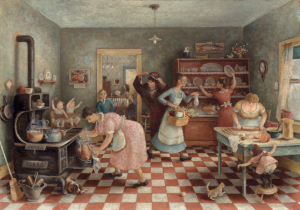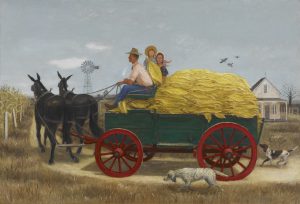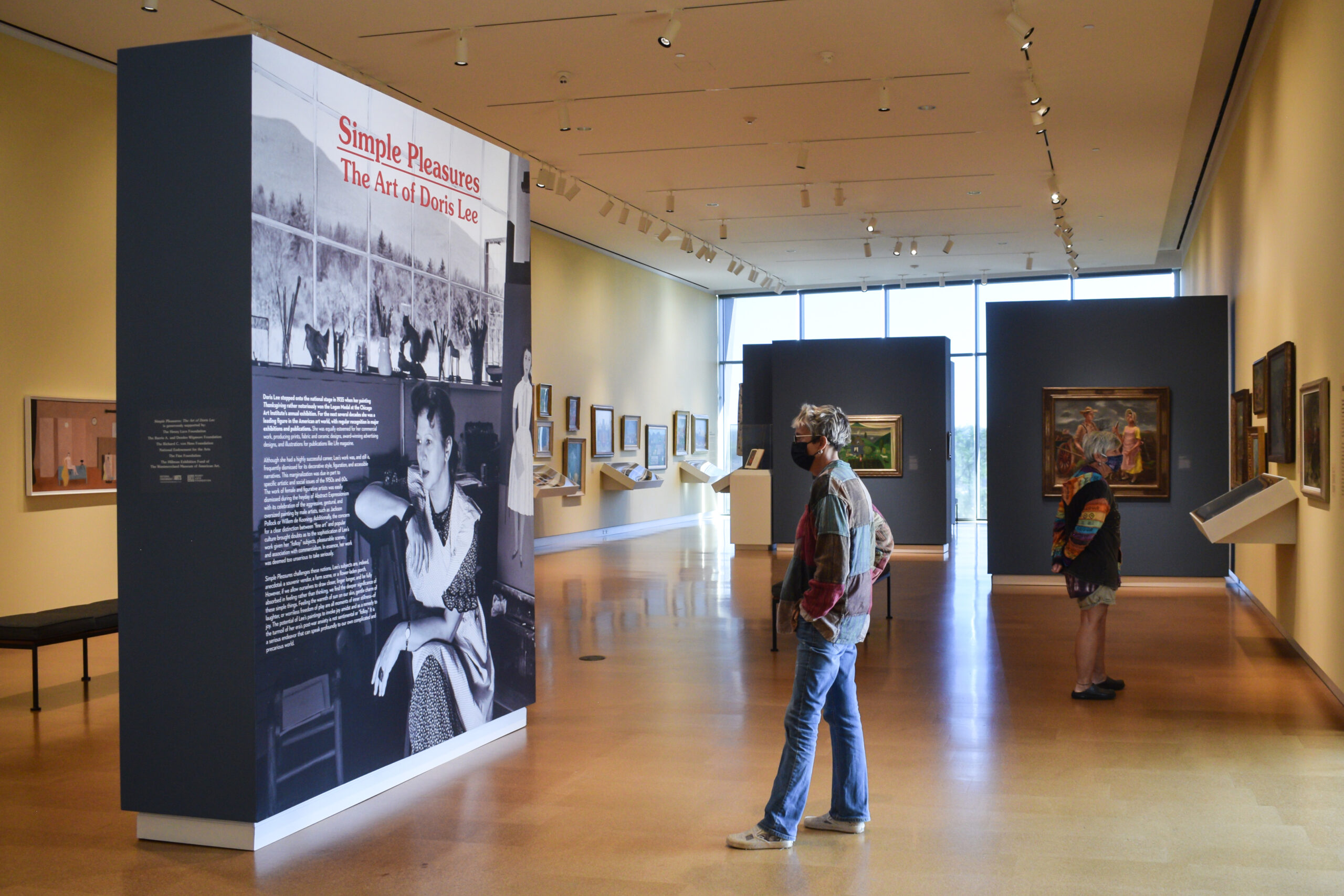Simple Pleasures: The Art of Doris Lee Exhibition Overview
Simple Pleasures: The Art of Doris Lee presents the first major critical assessment of works by the artist Doris Lee (1904 – 1983). Lee was one of the most recognized artists in the country during the 1930s and 1940s, and was a leading figure in the Woodstock art colony. In response to the rise of Abstract Expressionism in the decades after World War II, Lee deftly absorbed these innovations into a continuation of her own visual style, unlike many American Scene colleagues whose work shows them either rejecting abstraction or adopting it in rejection of their former figurative and communal concerns. Lee’s oeuvre reveals a remarkable ability to merge the reduction of abstraction with the appeal of the everyday. In so doing, she offers one of the very rare examples of a coherent visual identity that successfully bridged the various artistic “camps” that formed with the shift in the art world in the post-World War II era—whether those camps were between commercial and fine, or competing art styles.

Logan Purchase Prize Fund, 1935.313, © Estate of Doris Lee, Courtesy D. Wigmore Fine Art, Inc.
Although Lee had been accepted into the Whitney Museum of American Art’s 1932 Biennial, she exploded onto the national scene in 1935 when her painting Thanksgiving was awarded the Chicago Institute of Art’s Logan Prize. It was the indignant response to the painting by Mrs. Josephine Hancock Logan, the prize’s namesake, who declared Thanksgiving “awful, atrocious, and unspeakable” that brought the artist and the strengths of her painting to national attention, instigating the (short-lived) Sanity in Art movement. Two years later, her painting Catastrophe was purchased by the Metropolitan Museum of Art. The exhibition explores this initial national recognition in the 1930s within the context of American Scene painting, and traces the artist’s thematic interest in the simple objects and scenes of the everyday through her career. The exhibition also examines the influence of the rise in abstraction during the late 1940s and 1950s, and the particular way in which this abstraction found resonance with Lee’s long-held interest in, and collections of, folk and non-western art. The exhibition also explores Lee’s responses to both the artistic and natural environment of Woodstock, NY, where she lived for her entire professional career, and her work in Florida where she resided during the winter months in the 1950s and 1960s. While genre comprises the majority of her life’s work, Lee was deeply responsive to the natural world, and the exhibition includes a group of her moody landscapes and graceful still lifes. Similarly, the exhibition also examines Lee’s female imagery, evocative for the figures’ independence and physical liberation.
During the post-war period, Lee, like many of her American Scene colleagues, found lucrative work in the heyday of commercial advertising, often with the support of Reeves Lewenthal, Director of her New York gallery, Associated American Artists. Lee’s commercial commissions included product ads for the American Tobacco Company, General Mills, and the United States Brewers Association, among others. She was hired by Life magazine as an artist-correspondent to cover stories about Hollywood, Broadway, and fashion, as well as to create illustrations of her travels in Africa, Mexico, South America, Cuba and the Caribbean. These paintings and drawings serve as snapshots of the people and places she visited. Mademoiselle, Seventeen, Vogue, Charm, Saturday Evening Post, McCalls and other popular magazines commissioned Lee to illustrate their stories while corporations like Abbott Laboratories and Standard Oil Company used her illustrations for their in-house magazines. She made five paintings and 83 drawings for The Rodgers and Hart Song Book published in 1951. This body of commercial work is especially compelling in both its populist accessibility and deceptively sophisticated abstraction.

Bentonville, AR, 2007.184 © Estate of Doris Lee, Courtesy D. Wigmore Fine Art, Inc.
Photo: Dwight Primiano
This exhibition and its scholarly catalogue participate in the process of questioning and broadening the narrative of American art by presenting the fullness of one artist’s oeuvre, as well as the professional strategies she employed to negotiate the art world of this time. They will bring another voice that works to create a canon of American art more complicated and inclusive, not just because another artist is added into the narrative, but because the work of this particular artist, Doris Lee, brings a reconsideration of figuration and humor, of women’s artistic strategies, and of abstraction that strengthens this story considerably.

Co-curated by Barbara L. Jones, Chief Curator, The Westmoreland, and Melissa Wolfe, Curator of American Art, Saint Louis Art Museum, the exhibition includes over 70 works of art by the artist spanning her 40-year career from the 1930s through the 1960s. Paintings, drawings, prints, commissioned designs in fabric and pottery, and a selection of her highly regarded commercial commissions on loan from 58 lenders, comprise the exhibition. A 240- page, fully illustrated, full-color catalogue accompanies the exhibition and is available in the Museum Shop and online. Essays were contributed by Wolfe, Jones, John Fagg, Professor of American Studies, University of Birmingham, UK, and Tom Wolf, Professor of Art History at Bard College, NY. Amy Torbert, Andrew W. Mellon Foundation Assistant Curator of American Art at Saint Louis Art Museum, compiled the comprehensive chronology.
The exhibition will travel to three additional venues: Figge Art Museum, Davenport, IA (February 5 – May 8, 2022); Vero Beach Museum of Art, Vero Beach, FL (June 5 – September 18, 2022); and Dixon Gallery and Gardens, Memphis, TN (October 30, 2022 – January 15, 2023) providing the opportunity for broader recognition of Lee’s important contribution to American art.
Simple Pleasures: The Art of Doris Lee is generously supported by The Henry Luce Foundation, The Barrie A. and Deedee Wigmore Foundation, The Richard C. von Hess Foundation, the National Endowment for the Arts, The Fine Foundation, and the Hillman Exhibition Fund of The Westmoreland Museum of American Art.
